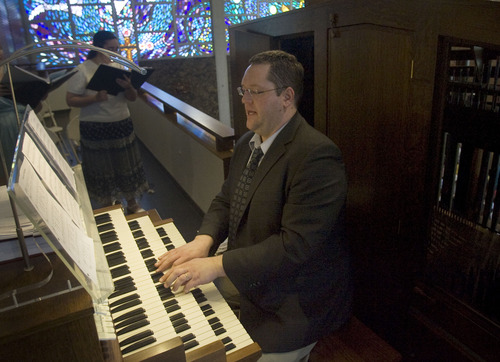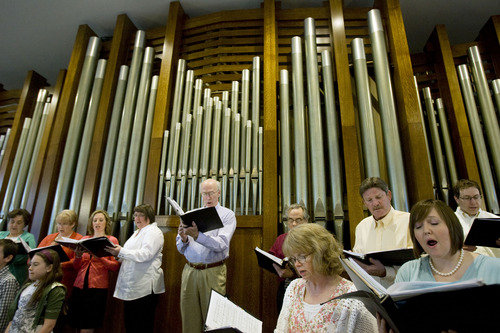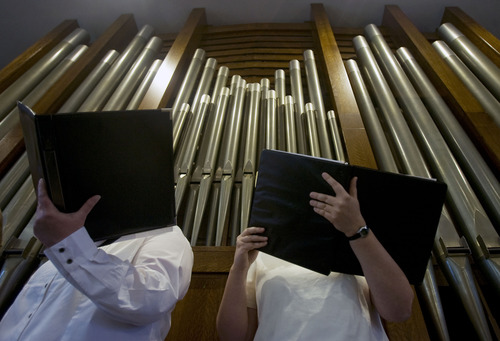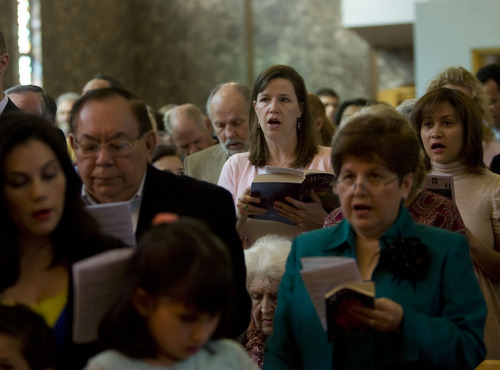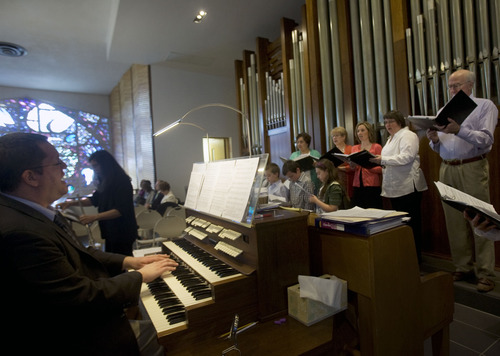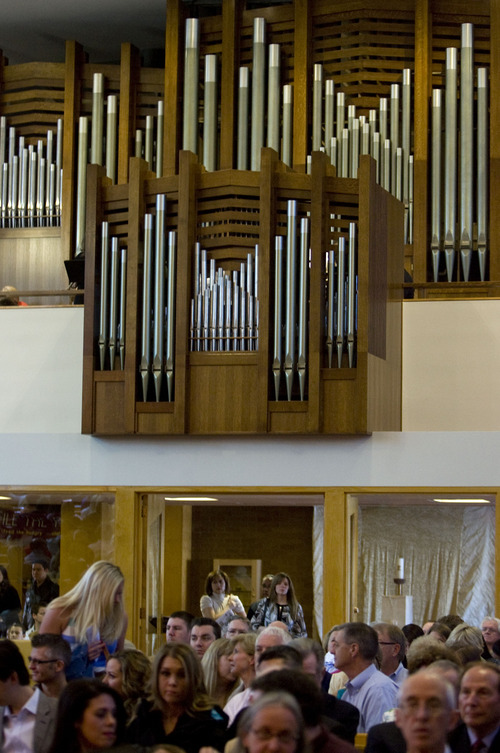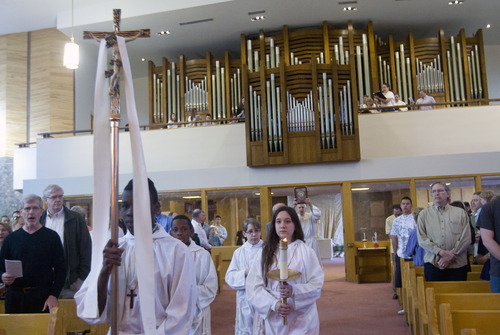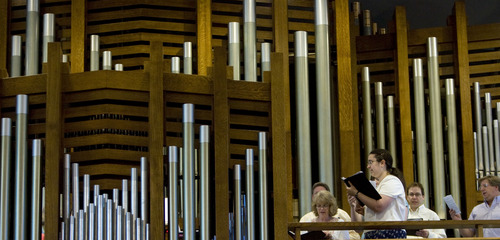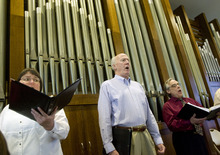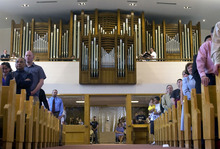This is an archived article that was published on sltrib.com in 2013, and information in the article may be outdated. It is provided only for personal research purposes and may not be reprinted.
The pipe organ inside Salt Lake City's St. Ambrose Catholic Church was undersized and had outlived its usefulness.
But Chris Huntzinger, the church's music director, knew there was a way to expand the seven-rank Wicks organ even with the church's limited budget.
All he needed was an organ donor.
About 2 1/2 years ago, the Episcopal Cathedral Church of Saint Mark in downtown Salt Lake City had put its Holtkamp organ in storage after buying a new instrument that would re-expose an ornate rose window.
Even though it was no longer being used, retired Episcopal pastor Frederick Q. Lawson wanted to keep the Holtkamp organ in Salt Lake City.
A plan was hatched to blend the two instruments into one.
The project required more than Lawson's generous donation of the organ. The St. Ambrose ceiling needed to be raised, and the organ loft had to be expanded to accommodate the extra pipes for the merged organs.
The church mounted a fundraising campaign that brought donations from throughout the community and across the country, including a major donation from the Roper Family in honor of their parents, George and Ada, two of the church's founding parishioners.
And an ecumenical effort by the Catholic, Episcopal and LDS churches brought in sufficient funding to complete the project.
"It was just pure opportunity and a wonderful story, seeing it happen," Huntzinger said, adding that pipe organs are meant to be used by the entire community.
History • Mormon Tabernacle organist Clay Christiansen spent 10 years during the 1960s and 1970s as the organist at St. Mark's. During that time, he developed a special affinity for the Holtkamp organ, from which he broadcast a weekly program on KWHO radio and later on KBYU, Classical 89. He was especially happy to see it get a new life. "I was delighted, because I so liked the organ and dreamed it could be used again," he said.
Catholic Bishop John C. Wester dedicated the new blended organ in January during a choral vespers service. It was followed by an organ recital by Christiansen, who also gave the audience a glimpse into the reconstruction process. Two additional concerts, which are free, are scheduled Sunday, April 28, and Friday, June 7. (See box.)
The organ already is being used by four students from the neighboring Cosgrove School, a University of Utah master class and a Brigham Young University student performing a senior recital.
Bigelow & Co. — the company that also created the new St. Mark's organ — won the contract to blend the two instruments into one. The cabinet that houses the pipes incorporated a chevron pattern that is featured prominently throughout the church. The striking stained-glass windows were also considered in the concept. "They have a wonderful movement, action and life of their own," said company founder and president Michael Bigelow. "I wanted a flowing line of pipes that provided interest like the windows."
Besides combining the Holtkamp and Wicks organs, a full rank of new trumpet pipes was added, bringing the total number of pipes to 2,797. After installation, the organ performed beautifully in its new home with no sign of rejection.
"We were fortunate that the space was acoustically live and very warm, so the organ has a warmer and kinder sound than it did when installed at St. Mark's," Bigelow said. This meant that relatively little adjustment or voicing had to be performed for the pipes to reach their optimal sound.
The company's vice president in charge of sound, David Chamberlin, also an accomplished organist, said voicing the pipe organ is a delicate art, requiring the technician to increase or decrease the loudness of pipes while carefully adjusting the tone quality. That is done by slightly bending the soft metal around the pipe's mouth to create the perfect blend of sound. Creating a cohesive sound between the two blended organs also complicated the job.
Chamberlin described the St. Ambrose organ as an eclectic instrument, performing well in a variety of styles from Baroque, Classical and Romantic period music to modern compositions.
"If it has a weakness, it is that it doesn't have a loud and striking reed sound … nothing that will knock you over," Chamberlin said. But that isn't necessarily a bad thing, especially in the acoustically inviting atmosphere of St. Ambrose.
"It has a wonderful range of color and dynamic," he said, "everything you want as an organist."
Hear the organ
The second of three free concerts will feature the combined choirs of St. Ambrose and St. Mark, performing Louis Vierne's "Messe Solennelle" and John Stainer's "I Saw the Lord."
When • Sunday, April 28, 7 p.m.
Where • St. Ambrose Catholic Church, 1975 S. 2300 East, Salt Lake City
Tickets • Free
Next • The final organ concert will be Friday, June 7, featuring a recital by David Chamberlin of Bigelow & Co. — the company that helped create the new organ. —
Pipe organ 101
Making beautiful organ music requires a lot of parts.
Pipes • Pipe organs contain two types of pipes: flue and reed. Flue pipes work like a flute, creating vibration when a column of air is split as it passes across the pipe's mouth; reed pipes contain a thin, metal reed that vibrates as air passes across it.
Windchest • Pipes are housed in a windchest that is enclosed on the sides and back so sound projects forward. While some pipes usually are visible, most are out of sight.
Voices • Each pipe generates a single characteristic tone, requiring 61 pipes to play a five-octave chromatic scale for each set of an organ's characteristic sounds or voices. A set of voices is called a rank. Some voices are created by combining more than one rank.
Stops • An organ stop blocks or stops air from flowing to all ranks except the one chosen. A single stop or voice may be selected or used in combination for a mixture of tones. Separate stop combinations may be selected for each of the console's manuals and foot pedals. An organist may program stop settings in the organ's memory for deployment with the touch of a button.
Blowers • A blower pumps air to the bottom of pipes through the windchest. A valve mechanism directs the air to the specific pipe or combination of pipes when the organist presses a key or foot pedal. The valve mechanism is activated mechanically on tracker organs and electronically on organs with electro-pneumatic mechanisms. Most modern pipe organs are of the electro-pneumatic variety, including the St. Ambrose organ.
Sources: http://www.lawrencephelps.com (pipe organs 101); Chris Huntzinger; Clay Christiansen; David Chamberlin; Michael Bigelow



